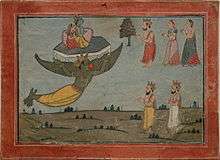Parijata

The word, Pārijāta (Sanskrit: पारिजात), – refers to the Indian coral tree, night-flowering coral jasmine, or simply fragrance. But, written and pronounced as Parijāta (Sanskrit: परिजात) it means - descended from, begotten by or fully developed.[1]
In Hindu mythology, the celestial Pārijāta tree is the tree of the universe which is owned by Indrani and planted in svarga located between heaven and earth, which tree, also known as Kalpa-taru, is believed to yield all objects of desire.[2] This tree is identified with the Mandāra tree.
From the Bhagavata Purana, the Vishnu Purana and the Mahabharata it is learnt that the elaborate process of Samudra manthan of primal waters of the cosmic ocean yielded the Pārijāta tree as one of the three valuables, this tree, said to have blossomed atop Mount Meru in the garden of paradise and identified with the Indian coral tree, was claimed by Indra no sooner it rose to the surface and emitted its fragrance. [3][4]
Krishna is believed to have stolen the Pārijāta flower from Indra’s paradise to which act pārijāta-harana (removal of the Pārijāta tree from heaven), which has two forms in the Harivamsa, relates; according to the puranas, at the behest of his wife, Satyabhama, Krishna had uprooted the pārijāta tree from the Nandana-vana of Indra and brought it to Dwarka though it has no role in rituals and is not associated with the world of humans, being merely a possession of sorts.[5]
In Hindu astrology, the word, Pārijāta, refers to a Rāja yoga based on the Planetary Dispositor Principle. This planetary combination called Pārijāta yoga arises if the lord of the sign occupied by the lord of the Lagna (Ascendant) and the lord of the sign occupied by the dispositor of the lord of the lagna both, or if the lords of the navāmsas occupied by these two lords are situated in a kendra or a trikona from the lagna-kendra in their own or exaltation signs. Parasara states that the person blessed with Parijata yoga will be fond of battles, strong-willed, full of determination, fearless, adept and successful, kind-hearted, forgiving and generous, have faith in Dharma and Karmas, a proud possessor and enjoyer of wealth and comforts and the one who leads a royal life during his or her middle and last part of life.[6][7] Pārijāta yoga is a combination of the Parvata yoga and the Kahala yoga. Gautama Buddha was blessed with this yoga.
References
- ↑ Sanskrit-English Dictionary. Spokensanskrit de.
- ↑ Encyclopedia of Ancient Deities. Routledge. p. 373.
- ↑ Anita Nair. Why the Parijata Tree came Down to Earth. Penguin.
- ↑ the Handbook of Tibetan Buddhist Symbols. Serindia publications. p. 193.
- ↑ Michael Charles Baltutis. The Festival of Indra. Proquest. pp. 61,78, 79,82.
- ↑ Bṛhat Parāśara Horāśāstra 2002 Ed. Manoj Pocket Books. p. 190.
Sloka 41&42
- ↑ B.V.Raman. Three Hundred Important Combinations. Motilal Banarsidass. p. 70.
